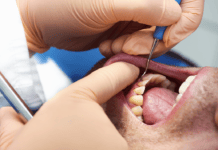The idea of “naturally” curing tooth decay is a fast-growing fad. It has become such a craze that Facebook pages and groups encourage and support the idea. I’ve recently learned of one such group called “Cure Tooth Decay – Heal Tooth Cavities, Dental Caries, Tooth Abscess,” which is well known for supporting this fad. It is a closed group that you must be accepted into to join.
Full disclosure, I am not a member. However, I have seen posts from this group, mainly from other dental professionals, who have gained access and tried to educate people on the importance of seeking professional dental care.
I admire the dental professionals trying to educate – they are dental missionaries. I don’t generally get into arguments on the internet, no matter how strong my feelings are on a subject. For the most part, I read the stories the missionaries bring back to the dental groups, but I don’t allow myself to get too terribly upset.
However, when several dental missionaries shared the same story multiple times, it piqued my interest, or rather, my concern. It was posted by a mother, who was seriously distraught that her almost two-year-old had rampant caries across her upper anterior teeth, and two of the teeth were decayed to the gingival margin. The mother admitted she was aware the two severely decayed teeth would probably require extraction.
I don’t understand why you would avoid professional dental care to repair a tooth while acknowledging the need when the tooth is no longer salvageable. To add insult to injury, after watching this happen to your child, why would you continue this lifestyle? It made me so sad. I simply don’t understand choosing this for your children – it seems absurd.
The Basis of the Beliefs
I decided to go to the page and contacted the administrator to see if they would be interested in a civil, non-judgmental interview to help me better understand their beliefs and practices. Side note here: There are two pages, including a private “discussion forum” and a public page. This is when I discovered there are almost 68,000 members in this forum! My head exploded!
How in the world has dentistry failed this many people?! I sent a private message. I was desperate to know if it was due to the financial burden, fear, lack of trust, or a blatant disregard for modern medicine in general. I was curious if they believed in avoiding medical doctors as well.
Unfortunately, but not surprisingly, I did not get a response. My message was very kind and unthreatening, but no dice. However, I did discover the basis of their beliefs come from the book Cure Tooth Decay: Remineralize Cavities and Repair Your Teeth Naturally With Good Food by Ramiel Nagel. I would love nothing more than to have a sit down with Ramiel Nagel. Unfortunately, he died from cancer on July 28, 2017.
Because I couldn’t get a response via Facebook and Mr. Nagel is no longer with us, I decided to do my own search and see what I could learn about him and his recommended practices to cure tooth decay. His biography does not mention any formal education – dental, medical, or otherwise. It only states, “His background is in body-oriented psychology, energy medicine, and yoga, and his writings focus on empowerment and self-responsibility in relation to health.”
Originally, I thought I would buy and read Nagel’s book, but I couldn’t bring myself to pay $28.00 for something I just do not support. So, I decided to cheat and go to his website to soak up as much inaccurate information as possible.
To sum it up, what I learned about Nagel’s recommendations comes down to this: He claims tooth decay is caused by nutrient deficiencies and not bacteria. He also implies that by simply changing your diet, you can cure dental decay. If you are interested in exploring Ramiel Nagel’s work further, you can go here.
I also ran across an interview with Mr. Nagel on a blog named Kitchen Stewardship. My favorite quote from the interview is, “From my understanding, there should be more than one sign to indicate it needs to be filled. In other words, don’t get a filling just from a spot on an X-ray. This is still a form of conventional perspective. Even if an active cavity is found, it can still be remineralized, and drilling can be avoided. Often these types of cavities can be remineralized in two to six weeks time. Seeing one spot on an X-ray is not good justification.”
I believe nutrition plays a key role in dental and overall health, and incipient lesions can and do remineralize, and they do not require treatment. I thought incipient lesions were what Nagel was referring to, but you can find a radiograph of a tooth with severe decay, which the website claims is healing. You can see a large temporary filling that has been placed with the indication of secondary dentin. The image is copyrighted so you will have to go here to see it.
So, why am I writing all this?
The first reason is that I can’t stop thinking about it. I’m concerned for all the people who really believe in this practice. The second and most important reason is that I hope at least one person will read this and be educated on the dangers of curing tooth decay “naturally.”
Before I go further, I would like to say to my critics that I know some of the following information is extreme. In my defense it is science-based, and I personally feel like trying to cure a cavity with raw milk and cod liver oil is extreme. Therefore, I’m just following Ramiel Nagel’s lead. Keep reading for science-based facts.
Life-Threatening Infections of Odontogenic or Upper Airway Origin
Life-threatening infections of odontogenic (tooth or surrounding tissue) or upper airway origin may extend to potential spaces formed by fascial planes of the lower head and upper cervical area. Complications include airway obstruction, mediastinitis, necrotizing fasciitis, cavernous sinus thrombosis, sepsis, thoracic empyema, Lemierre’s syndrome, cerebral abscess, orbital abscess, and osteomyelitis.1
The incidence of these “space infections” has been greatly reduced by modern antibiotic therapy. However, odontogenic infections have been one of the most common diseases in the oral and maxillofacial region, associated with a mortality rate of 10% to 40%.1
I would like to add, that if you are following Ramiel Nagel’s advice, you refuse antibiotics. So, let’s dig into some of these complications that could arise.
Sepsis: Defined as the presence of confirmed or suspected infectious agents with two or more of the systemic inflammatory response syndrome criteria.1
Systemic inflammatory response syndrome criteria include body temperature less than 96.8 degrees or greater than 100.4 degrees, heart rate greater than 90 beats per minute, respiratory rate greater than 20 breaths per minute, or white blood cell count greater than 12,000 or less than 4,000.1
In a survey conducted, 18 deaths were reported out of 2,790 patients. One case included a nine-year-old patient developing toxic shock syndrome secondary to dental abscesses. Despite the treatment, the patient died two days after admission to the intensive care unit because of multi-system organ failure.1
Respiratory obstruction: This is another most concerning complication of odontogenic infections. Respiratory obstruction may be due to the swelling of the floor of mouth, trismus, edema, and abscess formation, leading to narrowing and eventually to the loss of airway.1
Tracheal intubation in patients with deep neck infections is challenging. Distorted airway anatomy, tissue immobility, and limited access to the mouth make orotracheal intubation with rigid laryngoscopy difficult.1
No airway = no oxygen. You can do the math.
Descending necrotizing mediastinitis: Of the reported cases of descending necrotizing mediastinitis, 60% to 70% originate from odontogenic infections. Although descending necrotizing mediastinitis is quite rare, this variety of mediastinitis is a highly lethal disease with a mortality rate of 37% to 60%.1
It is frequently associated with pleural and pericardial effusion, compression of the local blood vessels, persistent sepsis, and multi-organ failure.1
Lemierre’s syndrome: Characterized by suppurative thrombophlebitis (venous thrombosis associated with inflammation in the setting of bacteremia) of the internal jugular vein, is a metastatic infection.1
In a literature search for Lemierre’s syndrome, the primary site of infection was the oropharynx in 59.5% of cases, followed by mastoiditis (15%), and seven cases with a primary odontogenic infection.1
In the pre-antibiotic era, Lemierre’s syndrome carried a mortality rate of 83%. Reminder: If you follow Ramiel Nagel’s advice, you are living in the pre-antibiotic era.1
Cervical necrotizing fasciitis: Characterized by an extensive, severe progressive infection with dissection and necrosis of the soft tissues along the cervical planes, the mortality rate is in between 20% and 40%.1
Bacterial enzymes and cell wall components play an essential role in local tissue destruction, dissemination of the infection, and in systemic toxicity. If left untreated, the rapid dissemination of the infection can be fatal.1
Orbital abscess: Organisms from an odontogenic source may gain entrance to the orbit through local tissue planes, by hematogenous (blood) spread, or via involvement of the paranasal sinuses. The orbital septum delineates these infections into pre- and post-septal disease, which is important because the latter has the potential to cause severe complications.1
Orbital abscesses exhibit common signs and symptoms such as chemosis (swelling of the conjunctiva), swelling of the eyelid, reddening, hyperthermia, proptosis (protrusion or displacement of the eye), extraocular muscle dysfunction, and decreased visual acuity.1
Retrograde spread of infection can lead to complications such as cavernous sinus thrombosis, meningitis, cerebritis, brain abscess, or death.1
Cavernous sinus thrombosis: Septic cavernous sinus thrombosis is a rare condition. Seven percent of all cases of thrombosis of the cavernous sinus are of dental origin.1
Though it is rare, fewer than 40% of patients usually have a full recovery, while the remainder of patients have neurological deficits. Death generally occurs within four to seven days if the diagnosis is not made or when treatment is not instituted, usually due to meningitis, brain abscess, or generalized sepsis.1
Brain abscess: Anaerobic species are responsible for the majority of cases of odontogenic (78%) brain abscess. Clinically, there is usually a latent period of several days or weeks before symptoms of intracranial involvement appear. Initial symptoms may be mild, consisting mostly of headaches, malaise, and apathy. Neurologic signs may appear later, depending on the location of the lesion.1
In a case study published in the Journal of the Canadian Dental Association, a primary molar dental abscess was implicated as the cause of a brain abscess in an 11-year-old boy. You can read the case study here.2
Osteomyelitis: Defined as an infection in a bone. Osteomyelitis may develop in the jaws after a chronic odontogenic infection. Odontogenic infections were found to be the cause of 38% of mandibular and 25% of maxillary involvement. Proper surgical management and antimicrobial therapy are a must to avoid complications.1
In Closing
With the widespread availability of preventive dental care and the development of effective antibiotics for the treatment of orofacial infections, the incidence of serious odontogenic infections has decreased dramatically over the past 50 years. However, they can still carry the potential for lethal complications, especially in the immunocompromised patient.
When considering a “natural” cure for any dental or medical disease, the consequences could be painful at best and life-threatening at worst. Blindly following recommendations by an unqualified individual is dangerous. I know there are many people who would like Ramiel Nagel’s practice to be true and successful. However, there is no science-based evidence to support his claims.
Nutrition and a healthy lifestyle are important in disease prevention, and I highly recommend choosing a healthy diet. However, if you or your child has a dental or medical problem, I encourage you to seek professional treatment and guidance from a qualified individual. Obtaining medical or dental advice from a book that can be purchased online, written by an individual with no medical or dental background, is not a substitute for actual dental or medical advice from a board-certified dentist or physician.
Now Listen to the Today’s RDH Dental Hygiene Podcast Below:
References
- Bali, R.K., Sharma, P., Gaba, S., et al. A Review of Complications of Odontogenic Infections. Natl J Maxillofac Surg. 2015; 6(2): 136-143. https://www.ncbi.nlm.nih.gov/pmc/articles/PMC4922222/
- Hibberd, C.E., Nguyen, T.D. Brain Abscess Secondary to a Dental Infection in an 11-Year-Old Child: A Case Report. J Can Dent Assoc. 2012; 78: c49. https://jcda.ca/article/c49












